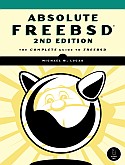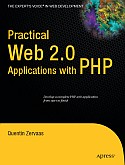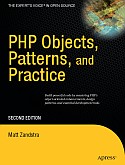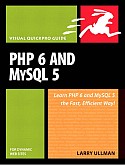5977 / 1
 БончБруевич
БончБруевич,
Комментарии (-20)
This book teaches how to develop dynamic Web sites with PHP and MySQL, covering
the knowledge that most developers might require. In keeping with the format of the
Visual QuickPro series, the information is discussed using a step-by-step approach
with corresponding images. The focus has been kept on real-world, practical examples,
avoiding “here’s something you could do but never would” scenarios. As a practicing Web
developer myself, I wrote about the information that I use and avoided those topics
immaterial to the task at hand. Asa practicing writer, I made certain to include topics
and techniques that I know readers are asking about.
The structure of the book is linear, and the intention is that you’ll read it in order.
It begins with three chapters covering the fun damentals of PHP (by the second chapter,
you will have already developed your first dynamic Web page). After that, there are
three chapters on SQL (Structured Query Language, which is used to interact with all
databases) and MySQL. They teach the basics of SQL, database design, and the MySQL
application in particular. Then there’s one chapter on debugging and error manage-
ment, information everyone needs. This is followed by a chapter introducing how to
use PHP and MySQL together, a remarkably easy thing to do.
The following five chapters teach more application techniquesto round out your
knowledge. Security, in particular, is repeatedly addressed in those pages. Chapter 14,
“Making Universal Sites,” is entirely new to this edition of the book, showing you how
to broaden the reach of your sites. Finally, I’ve included three example chapters, in
which the heart of different Web applications are developed, with instructions.
Is this book for you?
This book was written for a wide range of people within the beginner-to-intermediate
range. The book makes use of XHTML for future compatibility, so solid experience
with XHTML, or its forebear HTML, is a must. Although this book covers many
things, it does not formally teach HTML or Web page design. SomeCSS is sprinkled
about these pages but also not taught. Second, this book expects that you have one
of the following:
- The drive and ability to learn without much hand holding, or…
- Familiarity with another programming language (even solid JavaScript skills About This
Book would qualify), or…
- Acursory knowledge of PHP Make no mistake: Thisbook covers PHP and MySQL from Ato Z,
teaching everything you’ll need to know to develop real-world Web sites, but
particularly the early chapters cover PHP at a quick pace. For this reason I
recommend either someprogramming experience or a curious and independent spirit
when it comes to learning new things. If you find that the material goes too quickly,
you should probably start off withthe latest edition of my book PHP for the World Wide
Web: Visual QuickStart Guide, which goes at a more tempered pace.
No database experienceis required, since SQL and MySQL are discussed starting at a
more basic level.




